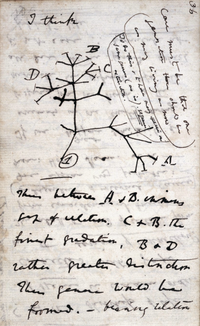Maladaptation
| Part of the Biology series on |
| Evolution |
|---|
 |
| Mechanisms and processes |
| Research and history |
| Evolutionary biology fields |
In evolution, a maladaptation (/ˌmælædæpˈteɪʃən/) is a trait that is (or has become) more harmful than helpful, in contrast with an adaptation, which is more helpful than harmful. All organisms, from bacteria to humans, display maladaptive and adaptive traits. In animals (including humans), adaptive behaviors contrast with maladaptive ones. Like adaptation, maladaptation may be viewed as occurring over geological time, or within the lifetime of one individual or a group.
It can also signify an adaptation that, whilst reasonable at the time, has become less and less suitable and more of a problem or hindrance in its own right, as time goes on. This is because it is possible for an adaptation to be poorly selected or become more of a dysfunction than a positive adaptation, over time.
It can be noted that the concept of maladaptation, as initially discussed in a late 19th-century context, is based on a flawed view of evolutionary theory. It was believed that an inherent tendency for an organism's adaptations to degenerate would translate into maladaptations and soon become crippling if not "weeded out" (see also eugenics). In reality, the advantages conferred by any one adaptation are rarely decisive for survival on its own, but rather balanced against other synergistic and antagonistic adaptations, which consequently cannot change without affecting others.
In other words, it is usually impossible to gain an advantageous adaptation without incurring "maladaptations". Consider a seemingly trivial example: it is apparently extremely hard for an animal to evolve the ability to breathe well in air and in water. Better adapting to one means being less able to do the other.
Examples
[edit]- Neuroplasticity is defined as "the brain's ability to reorganize itself by forming new neural connections throughout life".[1] Neuroplasticity is seen as an adaptation that helps humans to adapt to new stimuli, especially through motor functions in musically inclined people, as well as several other hand-eye coordination activities. An example of maladaptation in neuroplasticity within the evolution of the brain is phantom pain in individuals who have lost limbs. While the brain is exceptionally good at responding to stimuli and reorganizing itself in a new way to then later respond even better and faster in the future, it is sometimes unable to cope with the loss of a limb, even though the neurological connections are lost. According to the findings of one journal "Adaptation and Maladaptation" in some cases, the changes that had previously aided the human brain to best suit an environment could also become maladaptive.[2] In this case, with the loss of a limb, the brain is perceiving pain, though there are no nerves or signals from the now missing limb to give the brain that perception.
See also
[edit]- Black robin
- Ecological traps
- Evolutionary mismatch
- Maladaptive coping
- Evolutionary suicide
- Fisherian runaway
References
[edit]- ^ Neuroplasticity. (n.d.). MedicineNet. Web. 12 Nov. 2014, from http://www.medicinenet.com/script/main/art.asp?articlekey=40362
- ^ Nava, E., Roder, B., & Enhancing Performance for Action and Perception. (January 01, 2011). Adaptation and maladaptation. Progress in Brain Research, 191, 177–194.
Text is available under the CC BY-SA 4.0 license; additional terms may apply.
Images, videos and audio are available under their respective licenses.
